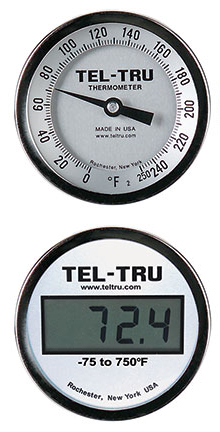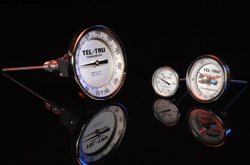Dial versus Digital Thermometers |
|
|
We frequently help customers determine the best thermometer for their application. Choosing between a dial (mechanical bimetal) and digital thermometer is a frequent question. Here are some pointers to help you make the best choice. VisibilityThe advantage leans toward digital for readability due to the numeric display. With a large display, it's easy to read temperature down to a tenth of a degree from several feet away.AccuracyQuality plays a huge role in determining the accuracy of the device. Digital thermometers may seem to be more accurate, but in reality good quality bimetal thermometers are very accurate as well. Both types should be checked for accuracy periodically and calibrated as needed. Calibration of a bimetal thermometer tends to be a pretty straightforward adjustment, while calibrating digital thermometers can involve additional equipment/software. |
 |
Sensor AreaThe sensor area in the stem of a digital thermometer that uses a sensor like an RTD is typically smaller than the sensor area in a bimetal unit which uses a spiral wound coil. This smaller sensing area can be an advantage if the media being measured is very thin.Response TimeThe response time for both types is largely determined by how quickly the metal components surrounding the sensor/bimetal coil heat up or cool down. Thermal conductivity, mass and ambient temperature all influence response time. In general, digital thermometers can have a slight advantage but it's typically not significant for most applications.One significant factor that impacts response time is the use of a thermowell. The change in temperature of the media needs to transfer through the mass of the thermowell, slowing the response. PriceThere are really too many factors such as quality, accuracy and features to provide meaningful advice, but all else being equal, digitals tend to be a little more expensive.PowerObviously, one major difference is that digital instruments need to be powered either by a battery or an external source such as loop power. With a good quality long life battery or available loop power, this shouldn't be a concern in most situations but if it is, a mechanical instrument may be a better choice.Ambient TemperaturesOne advantage a mechanical instrument has is the ability to operate reliability at higher ambient temperatures. Most electronic instruments have an upper limit of 175°F/80°C, while their mechanical counterparts can tolerate 200°F/94°C, depending on the lens type.When deciding between a mechanical thermometer such as a bimetal type and a digital thermometer, it really boils down to what is the best fit for the application, hopefully this guidance will help separate some of the facts from fiction. For additional product specifications, contact us. |
|


